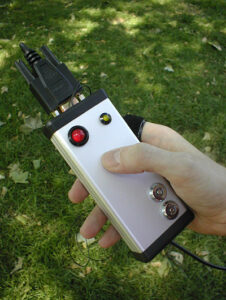 Hi, my name is Christian Nold and I started at the OU in September 2021 as a Lecturer in Design. In this text I want to introduce myself and offer a few themes from my work that might be relevant to both design teaching and research such as mapping, generative coding, Science and Technology Studies and systemic design. I think my strength is in bringing together design practice and theory and I want to present a little bit of both with a few links 😊.
Hi, my name is Christian Nold and I started at the OU in September 2021 as a Lecturer in Design. In this text I want to introduce myself and offer a few themes from my work that might be relevant to both design teaching and research such as mapping, generative coding, Science and Technology Studies and systemic design. I think my strength is in bringing together design practice and theory and I want to present a little bit of both with a few links 😊.
 For two decades I worked as an art and design practitioner creating participatory mapping projects with thousands of participants across sixteen countries. The Bio Mapping device I invented, measures people’s physiological arousal and their location together. People walk with the device for an hour and then talk about their journeys using the data which shows their ‘emotion’ as a spatialised cardiogram. In aggregate, this can then be used to create collective emotions maps of areas, towns and cities. Here is a book with some of the maps and related essays (Nold 2009) http://www.emotionalcartography.net . I also used this kinds of mapping approaches to create alternative local currencies http://theprotocity.com/money-traceability-local-economy-bijlmer-euro.
For two decades I worked as an art and design practitioner creating participatory mapping projects with thousands of participants across sixteen countries. The Bio Mapping device I invented, measures people’s physiological arousal and their location together. People walk with the device for an hour and then talk about their journeys using the data which shows their ‘emotion’ as a spatialised cardiogram. In aggregate, this can then be used to create collective emotions maps of areas, towns and cities. Here is a book with some of the maps and related essays (Nold 2009) http://www.emotionalcartography.net . I also used this kinds of mapping approaches to create alternative local currencies http://theprotocity.com/money-traceability-local-economy-bijlmer-euro.
Mapping is a powerful tool for bringing together radically different stakeholders and introduce qualitative methods into institutional processes (Nold 2018a). It is also great teaching tool and method for exploring, analysing and communicating personal understandings of the environment and systemic structures via non-geographical maps. I am keen to make mapping a foundational method for design teaching.
During these years, I was also teaching generative coding and physical computing using Processing https://processing.org and Arduino https://www.arduino.cc . These platforms were created to allow artists and designers to get involved in interactive computing and physical interaction using sensors and actuators. I was teaching architects at the Bartlett how to use these tools to implement environments that would respond to people’s presence and behaviour and to actively transform spaces. In the last decades interactive design platforms have evolved very far such as P5js https://p5js.org/ to the point where it has become very easy for anyone to get involved in algorithmic design with a very low threshold of technical knowledge and cost. I believe that learning to use these kinds of tools is fundamentally transformative beyond producing playful interaction. Creating one’s own algorithms is essential for being able to understand and engage with the social and political issues that are organising the world around us today.
In 2011, I returned to academia for a PhD using theories from Science and Technology Studies to look at citizen science — where the public collaborate with scientists on research projects (Haklay et al. 2020). My PhD (Nold 2017), was focused on environmental sensing devices that allow the public to create their own data. My role was to carry out long-term ethnographies that followed the design, implementation and usage of these devices and to narrate the often surreal incidents that happened around them.
Most people have heard about Bruno Latour, but Science and Technology Studies is a much richer area which has a lot more to offer design than has been explored in relation to Latour. Today, design is being tasked to deal with ‘wicked problems’ (Buchanan 1992) around climate change and social upheaval. Some areas of design such as systemic design try to engage with complexity (Nold 2021), while metadesign aims to redesign the design discipline itself, and to ‘re-language’ large scale societal paradigms. Yet, much of design is still focused on reductive ideas of singular users which make it hard to engage with issues such as climate change that seem large and distributed. Design practice and literature still hankers after the human subject and has a hard time engaging with sociotechnical systems. I think this is where Science and Technology Studies can contribute methods for experiencing and intervening into systems. For example, I am inspired by the work of Annemarie Mol and her concept of ‘ontological politics’ that helps to articulate how design creates different realities (Mol 2002). Also, Helen Verran’s work shows how to pay attention to one’s feelings of discomfort as an indicator of epistemic and ontological problems and then how to narrate them (Verran 1999). I have previously written about what I call practice-based ontological design (Nold 2018b), which aims to normatively open-up and foreclose certain realities. In the future I want to demonstrate this approach and set up a research project to test how this approach can create create meaningful difference for communities affected by sociotechnical controversies such as environmental pollution.
If any of this sounds interesting — please get in touch 😊.
References
Buchanan, Richard. 1992. “Wicked Problems in Design Thinking.” Design Issues 8 (2): 5–21.
Haklay, Muki, Alice Motion, Bálint Balázs, Barbara Kieslinger, Tzovaras Greshake Bastian, Christian Nold, Daniel Dörler, et al. 2020. “ECSA’s Characteristics of Citizen Science.” https://doi.org/10.5281/zenodo.3758668.
Mol, Annemarie. 2002. The Body Multiple: Ontology in Medical Practice. Durham and London: Duke University Press.
Nold, Christian. 2009. Emotional Cartography: Technologies of the Self. London: Softhook. http://emotionalcartography.net.
———. 2017. “Device Studies of Participatory Sensing: Ontological Politics and Design Interventions.” PhD thesis. University College London. https://discovery.ucl.ac.uk/id/eprint/1569340.
———. 2018a. “Bio Mapping: How Can We Use Emotion to Articulate Cities?” Livingmaps Review, no. 4: 1–16. http://livingmaps.review/journal/index.php/LMR/article/view/103.
———. 2018b. “Practice-Based Ontological Design for Multiplying Realities.” Strategic Design Research Journal 11 (2): 58–64. https://doi.org/10.4013/sdrj.2018.112.02.
———. 2021. “Towards a Sociomaterial Framework for Systems in Design.” 2. Social Design Institute UAL. London. https://www.arts.ac.uk/__data/assets/pdf_file/0034/286369/SDI_Working.Paper_2_Towards_a-Socio-material_Framework_Nold_tagged.pdf.
Verran, Helen. 1999. “Staying True to the Laughter in Nigerian Classrooms.” The Sociological Review 47 (S1): 136–55. https://doi.org/10.1111/j.1467-954x.1999.tb03486.x.

Leave a Reply